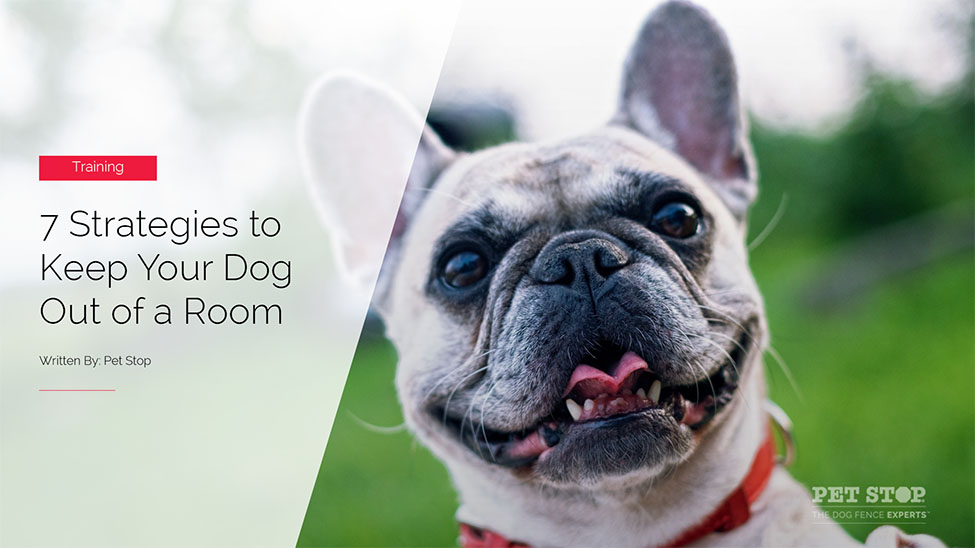
For most home owners, there’s a place in your home whether it be a bedroom, office, couch or furniture that you want to keep your dog out of. Often new puppies or dogs are always eager to follow you around in your home or be next to you at every moment while you’re home. This can cause some trouble especially when you’re trying to set boundaries early on. The best way to counteract this is to start training them from the get go. The longer you wait to train your dog to respect commands and boundaries, the more difficult it may become.
There are a variety of methods you can implement to help your dog understand boundary training. In this article, we’ll dive into some boundary training strategies and tips that will help you keep your dog within the boundaries you set for them in your home.

#1 – Teach Obedience Training Early On
First and foremost, you need to train your dog on the basics of obedience. Basic obedience commands like sit, stay, and come are the foundation of effective interaction and communication with your dog. By teaching your dog the basics of obedience training, he or she will be more likely to respect your commands and understand you to be their alpha. To help speed up the process of obedience training, always have treats on hand and positively reward your pet for doing the right things. Overtime, they’ll begin to understand right from wrong and will change their behaviors based on your training. Using obedience training will set the foundation and flow into other manners of discipline like off-leash training and on-leash training.
Creating a sense of obedience early will also help prevent the odds or occurrence of your dog becoming aggressive towards you or other animals.
#2 – Use a Pet Fence
Pet fences are a great way of keeping your dog out of certain areas. They’re effective because they provide an actual physical blockade so that the dog cannot enter the restricted space. Pet fences can be used for rooms, kitchens, and just about any area of the house. Make sure that you get the appropriate size fence depending on the space you have in your home and the size of your dog.

#3 – Use a Scent Deterrent
Using a scent deterrent is a great way to keep your dog from a restricted space. Scents like citrus, pepper, ammonia, mothballs, cayenne, red pepper and vinegar help repel dogs and keep them at bay. Set up a scent deterrent near the area you don’t want you dog to go near using a plastic cup or bowl filled with these ingredients.
#4 – Use Bumpy Flooring
A more uncommon strategy that most don’t know about. Bumpy floors generally feel uncomfortable when your dogs step on them so they can be a great way of deterring dogs from certain parts of your home. These can be in the form of plastic or rubber floor mats with various types of raised patterns on them which will prevent your dog from stepping on them.

#5 – Train Them With the Command “Out”
Out is a great basic command that should be taught to all dogs because it lets them know when they’re somewhere they shouldn’t be. Training your dog with this command is similar to many other types of obedience training. It involves positive affirmation and rewards when they listen to you so that they associate the word with something positive. When training the out command.
Make sure you say “out” with a commanding voice so that your dog takes the command seriously. Point to the direction they should move out of or move towards and gently move them towards that direction if they sit or lay down. Then point at the area they should not go towards and tell them “No!” in a commanding voice. With enough repetition of this method, they will become more familiar with “Out” command and what their boundaries are.

#6 – Designate a Spot for Them
Whether you use a bed, crate or cage you can set up a designated spot for your dog near the place they shouldn’t go. This doesn’t work in all cases, but it does in some. For example, if you’re restricted area happens to be an office where you work, then allow your dog into the room if they stay in their bed or cage which you set up for them. More often than not, your dog just wants to be around you because it wants your attention and company as opposed to wanting to cause trouble in your room, so having a designated spot that prevents any accidents is a great way to keep them around while preventing any mishaps.

#7 – Use External Correction and Reinforcement
There are various types of dog collars or mats available that can be used that provide a light static shock to your dog when they cross certain boundaries or lines. These can often be used a last resort when your dog is not learning or adapting to other training techniques. This method is generally regarded as safe because the static shocks are not severe enough or injure or hurt your puppy. This method is even more effective when coupled on top of other methods because it engages them physically as well.
Do you have a specific room or spot in your house that you’re dog is not allowed in? Let us know in the comments below and tell us about the most effective method you’ve found that helps keep your dog out of restricted areas. Also, if we happen to miss a strategy or tip that you’ve implemented, let us know about those as well!